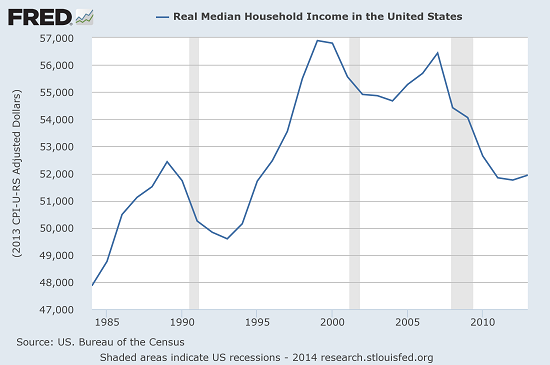Can the American middle class make a comeback?
There's no denying that the economic "recovery" from the housing bust and financial crisis has left a large swath of the population out in the cold.
The wealthiest Americans saw the quickest turnaround as stocks bottomed in early 2009 and started climbing to one new peak after another. Fueling that resurgence: plenty of cheap money courtesy of the Federal Reserve, near-zero interest rates and a rebound in corporate profits driven partly by the weak job market. Layoffs didn't dry up until the summer of 2009, when economists officially called the end of the recession.
But while stocks have zoomed to new records, home prices recovered some of their losses and businesses enjoyed record earnings, regular working Americans have been left behind. Wealth and income inequality has returned to Gilded Age extremes. The middle class is poorer than anytime since the 1940s, economists have shown.
Use of government welfare programs also remains high. Costs of living increased, driven by higher food, rent,and health care costs. Millions left the labor force and remain on the outside looking in. Hourly wages, on an inflation-adjusted basis, remain 7.5 percent below where they were in 1973.
But now, at long last, there are glimmers of a comeback for the middle class.
This is a key takeaway from Friday's blowout November jobs report, which featured a payroll gain of 321,000 jobs. That's the strongest initial print on this measure since October 2004 and caps the strongest run of job gains since the dot-com boom. The unemployment rate was unchanged at 5.8 percent, but the broader U-6 measure (which includes those marginally attached to the job market) dropped to 11.4 percent to its lowest level since the autumn of 2008.
Sure, it wasn't perfect, with blemishes if you know where to look. The labor participation and employment-to-population ratios were unchanged. Moreover, the number of full-time jobs dropped by 150,000 positions while part-time employment rose by 97,000.
Yet the overall impression is of a tightening labor market. This is corroborated by business surveys showing executives and small business owners are having a harder time finding workers, are planning to hire more workers, and are preparing to pay more for the workers that they can find and hire.
All of this suggests we're on the cusp of a long awaited, and much needed, bout of wage inflation. Average hourly earnings are growing at a meager 2.1 percent annual rate, or only slightly ahead of inflation. We need to see this increase at least above three percent to really start benefiting middle-class families that have seen their income stagnate for years, and even decades.
You can see in the chart above how inflation-adjusted median household income topped out at nearly $57,000 in 1999 but now stands at just under $52,000.
Philippa Dunne of the Liscio Report believes that it would take a few more months of hiring at the current pace "if the labor market is ever going to get back to normal" via higher take-home pay. Especially since the inflation-adjusted measure of average hourly wages is just 0.7 percent above where it was when the recession ended.


